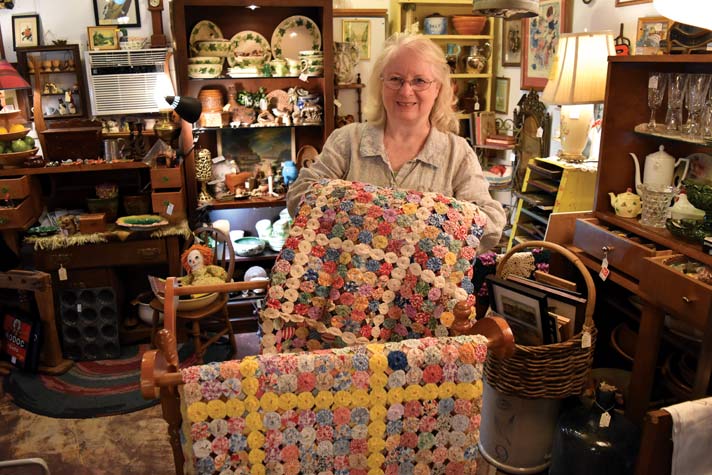Speaking of Antiquing – December 2017/January 2018
This the time of year when the coziness of a quilt is most appreciated. As the days and nights get colder, we spend more time cozied-up by the fire, or on the window seat with a good book. It can rain or snow as much as it likes while we are inside watching it. Plop on the sofa with a pile of pillows and a quilt and let the storms rage, I say!
A quilt, by definition, is a warm bed covering made of padding enclosed between layers of fabric and kept in-place by lines of stitching, typically applied in a decorative design.
Most of us will have a handmade quilt or two in the house made by a relative or ourselves.
They are works of art, made one stitch at a time. An unconventional style of “quilt” called the “Yo-Yo,” is neither padded nor stitched.
Quilters and seamstresses are notorious for saving bits of fabric that “can be used for something.” The beauty of making a yo-yo quilt is that the maker does not have to have sewing or quilting skills.
Small pieces of fabric are cut in a circle and sewn with a gathering stitch around the outer edge. The gathering stitch is pulled into a pucker and flattened into the center, creating the yo-yo. Hundreds of these are made and stitched together to make the yo-yo coverlet. Sometimes the combination is random, and sometimes patterns are created by placing colors together to form a design, much like beadwork or mosaic.
Worn-out dress fabric and feed sacks were the most common materials used. Sometimes the rounds were crocheted together. Sometimes the collection was lined with a backing fabric. Most vintage yo-yo quilts date from the 1920’s to 1940’s and were easy to make, with no sewing machine required.
As with conventional quilts, you can see a family’s outerwear history in the finished product!
Sometimes yo-yos were used to embellish blouses, dresses, pillows, and handbags. The yo-yo was finished with a colorful button in the center making a pretty flower, complete with embroidered stems and leaves.
Perhaps you have seen the vintage clown doll that is a series of stacked yo-yos creating the arms and legs. They are still popular and a fun item for children.
You can machine wash your yo-yo quilt on a gentle cycle, with a gentle spin. A dryer might be a bit harsh on it, so lay it out flat on a sheet outside to dry.
Mending a yo-yo quilt is easy, and replacing ripped yo-yos is simple, as most are held together with a simple whip stitch.
And don’t be afraid you use your heirloom quilt. While they look stunning on a bed, they can be used as window coverings, tablecloths, or displayed as show pieces on a wall.

 Margaret Barns is co-owner of Pickety Place Antiques & Collectibles located at 130 N. 4th Street in Jacksonville. LIKE them on
Margaret Barns is co-owner of Pickety Place Antiques & Collectibles located at 130 N. 4th Street in Jacksonville. LIKE them on